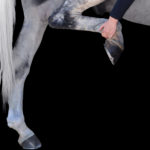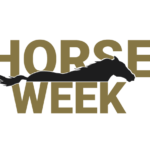January 20, 2013 — “I’ve been in training for this job all my life,” Chrystine Tauber, the new president of the U.S. Equestrian Federation, told me as the organization’s Pegasus Awards dinner celebration began winding down last night.
The training obviously paid off; she seems to have found her niche.
Once an international show jumper, she has held administrative or governance positions in several equestrian organizations and worked as a judge and course designer. Chrystine was poised (and quite glamorous, actually) when speaking at the awards ceremonies, appeared well-informed while addressing various issues, listened intently to the views of others and built confidence in her leadership during the five-day annual meeting.
We chatted in the “quiet room” (as opposed to the room where the band was going full force) about her experience over the week.
She led a standing ovation at the first board of directors session for her predecessor, David O’Connor, who spent nine years as the USEF’s first and only president. Present at the creation of the organization, which ended a bitter fight for NGB (national governing body) status between the U.S. Equestrian Team and USA Equestrian, David got the new group functioning. Not only was his prestige as an Olympic eventing individual gold medalist key to the effort, but his diligence and persistence crafted a federation that overcame a beginning forged from turmoil into a well-functioning entity operating with a surplus, which isn’t afraid to innovate and change as it works to oversee and improve the sport. And it still has plenty of work to do.
 David O’Connor got a standing ovation and a salute from Chrystine Tauber after ending his nine-year run as president of USEF | ? 2013 by Nancy Jaffer
David O’Connor got a standing ovation and a salute from Chrystine Tauber after ending his nine-year run as president of USEF | ? 2013 by Nancy JafferAlthough David walked to the back of the room after handing the gavel to Chrystine, he isn’t going away. He is the chef d’equipe for eventing now, though I suspect his counsel often will be sought as the USEF continues to evolve.
I wondered what David, who was honored with the Sallie Busch Wheeler award for “distinguished service to equestrian sport,” envisions for the future of USEF, since he’d done so much to forge it.
A central issue among the many dealt with in the forums that occupied the daytime hours was the subject of horses who routinely have been over-medicated and over-supplemented. It’s both an image problem and a long-running, multi-layered controversy and that at the moment is focused on the hunter ranks, where some trainers employ an unsavory variety of “calming” strategies, from supplements and medications to illegal drugs and interminable pre-competition longeing or riding.
A rule change took freshness, such as a tail swish or a head toss, out of the penalty category. Let’s hope judges abide by that as they mark their cards.
A change proposal that could be enacted down the road (but not too far down the road) called for limiting injections of most permitted substances to 12 hours or longer before a class. Aside from all the other problems, giving a horse a ringside injection doesn’t look good.
It was pointed out that many owners and amateur riders don’t know what their horses are “on.” Ask. Maybe you’ll get the truth. Some horses are being given a basket of supplements or whatever, and who knows how the substances will interact. Always best to tell the veterinarian what your horse is taking; provided you have that information. It’s likely medication logbooks will be available on the USEF website or as an app to help this situation, but the logbook is only as good as the person filling in the blanks.
 Sally Ike, the USEF’s new
Sally Ike, the USEF’s newEducation is a key factor in changing the medication abuse culture, as well as informing the membership of so many things they need to know. Recognizing that, the USEF is expanding the role of education in an initiative guided by Sally Ike, a longtime managing director of show jumping. She will be developing an online curriculum with Georgetown College, near USEF headquarters in Lexington, Ky., that can update and inform licensed officials via computer, along with members, trainers and veterinarians, and deal with a variety of subjects.
Another important discussion centered around the need for a division between the juniors and the adult sections that is missing from the effort to create a pipeline to the top in the international disciplines. That will involve linking the national side with the high performance side, which is also going to be helped by a new governance plan. It’s still developing, but it would cut the board of directors from 55 members to 20, and get working groups and FEI affiliates on the same page in a different format.
For some people, the annual meeting is all about awards, and the Pegasus ceremonies always stand out as a very special night. The USEF tried to make it more so by transporting everyone to Louisville’s historic Henry Clay building a few blocks away. A different format was tried; holding awards before dinner, with hors d’oeuvres to tide everyone over, then having the meal and dancing uninterrupted by presentations. The concept was interesting, though it wasn’t perfect.
In the effort to save time, some of the award winners were not given a chance to accept their trophy and make a speech. Their only moment in the spotlight came when video cameras (the event was live-streamed on the USEF network) were focused on them at their table.
The Equestrians of Honor deserve far more than that. For example, I was told that Anita Royston, the mother of leading Friesian trainer Bruce Griffin, had traveled 16 hours by bus from Virginia to see her son on stage. She just had to settle for sitting with him as a short video on his accomplishments was played. I’m assured that things will be different next year, but I felt for all those people who didn’t get the recognition they deserved after traveling to Kentucky. But Bruce, I’m told, will be honored at the Friesian national show, so hopefully that will make up for the oversight. It won’t help the others who missed out, though.
It was poignant to see the mother of para-equestrian Jon Wendt on hand as her late son was honored. Shortly after competing in the Paralympics and nearly getting a medal, this athletic young man was found dead in his apartment. Jon, who had started riding as therapy for cerebral palsy, was found to have had an “athlete’s heart,” a condition that can lead to cardiac arrest in young people.
He was among those from whom the Equestrian of the Year was chosen. The odds for that title were on Rich Fellers, the first American to win the World Cup show jumping finals in 25 years. The previous night, Rich’s mount, Flexible, got the International Horse of the Year trophy. Flexible wasn’t there of course, and neither was Rich yesterday; he got stuck in Denver due to plane trouble.
 Harry and Mollie Chapman, whose Flexible won International Horse of the Year title, with Chrystine Tauber | ? 2013 by Nancy Jaffer
Harry and Mollie Chapman, whose Flexible won International Horse of the Year title, with Chrystine Tauber | ? 2013 by Nancy JafferBut Flexible’s owners, the good humored Harry and Mollie Chapman, were on hand. Harry recalled the first time he heard about Flexible, a son of the great Cruising. Rich was telling him about “an ‘interesting’ Irish horse” (a designation open to a variety of interpretations). The first time Harry saw the little stallion, he thought the compact chestnut was a pony.
Harry acknowledged there were some bumps along the way, but “once the road was smoothed out, I have to say it was a hell of a ride.”
The National Horse of the Year honors went to Jersey Boy, winner of the USHJA International Hunter Derby. His rider, Jen Alfano, also was among those nominated for Equestrian of the Year.
 Olympic double-gold medalist Joe Fargis, flanked by Susie Hutchison and Chrystine Tauber, wears the silver cowboy hat trophy for the USEF’s Lifetime Achievement Award | ? 2013 by Nancy Jaffer
Olympic double-gold medalist Joe Fargis, flanked by Susie Hutchison and Chrystine Tauber, wears the silver cowboy hat trophy for the USEF’s Lifetime Achievement Award | ? 2013 by Nancy JafferThe biggest moment at the Pegasus dinner was no surprise. The Lifetime Achievement Award always is announced well in advance, so we know who will be trying on the iconic silver cowboy hat, the Jimmy Williams trophy, modeled on the headgear of the late trainer.
The fun comes from watching the video about the honoree, in this case, Joe Fargis, and hearing him speak. Joe, the 1984 Olympic double gold show jumping medalist (who will ever forget his final round at Santa Anita Park in Los Angeles on Touch of Class) and the 1988 team silver medalist in Seoul on Mill Pearl, is a reserved fellow.
His quiet dignity worked for him in the deliverance of his acceptance speech to his rapt audience, telling everyone to put the horse first and foremost and treasure our moments with them, as “one of the best ways to use one’s time on earth.” Joe also urged people to protect and guard the horse. Isn’t that exactly what the USEF is supposed to do?
The ceremony is always preceded by a compilation of videos featuring previous Lifetime Achievement Award winners, a tradition started by former American Horse Shows Association and USA Equestrian president Alan Balch.
We talked about how it all began in 1985.
Alan used to spend many hours assembling the videos, and is still involved in the process steered by USEF employees. With modern technology, of course, it’s a lot easier than it used to be, but the early ones are still fun to look at, a wonderful archive of horse sport honoring so many greats; both those who are still living and others who have ridden off into the sunset.
With the convention behind us, the competition year is really starting in earnest. Be sure to check back next Sunday for my postcard from the World Dressage Masters in Wellington. It should be quite a show.
Until then,







